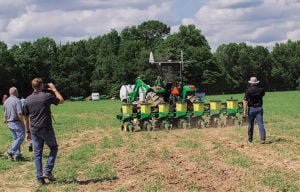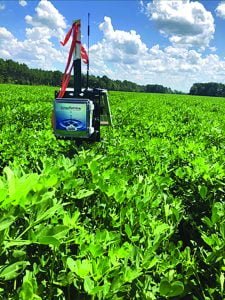Agribusiness entrepreneurs use technology to develop ideas that save them time, money

Agriculture is big business in the Hoosier state, and there’s still plenty of room to grow.
According to state estimates, Indiana ranks in the top 10 nationally in the 2017 production of corn, soybeans, peppermint, spearmint, watermelon, tomatoes, cantaloupe and pumpkins. Sales in 2017 reached $31.2 billion, with an additional $4.6 billion in exports.
Hoosiers are not resting on their laurels. By using a combination of technology, promotion and creative, out-of-the-box thinking, Indiana is making great strides on ways to improve efficiency and yield.
Out of the labs; into marketplace
John Hanak, managing director of Purdue Ventures, said former Gov. Mitch Daniels initiated the vision.
“Mitch wanted to get technology out of the labs and into the agriculture community,” Hanak said. “He wanted to remove barriers so that a business incubator could result in a startup and ultimately a major source of innovative tools and businesses for agriculture.”
AG-Celerator is a $2 million plant sciences innovation fund designed to provide critical startup support for Purdue innovators who wish to commercialize patented intellectual property or Purdue “know-how” technologies. Funding is considered for innovations that impact life sciences, advancing crop traits, generating higher yields, using big data to improve farm management, finding new uses of plants, using precision agriculture and discovering advanced breeding techniques.

“Every semester, we accept proposals that fit our criteria,” Hanak said. “We go through a process to determine which proposals merit additional funds to take their proposal to the next step. Then we award funds to help that idea become a commercial endeavor.”
Since AG-Celerator took root in 2015, funds have been awarded to 25 startup companies, including Hydro Grow LLC, Phicrobe LLC, VinSense Technology, Progeny Drone Inc. and Gen3Bio Inc.
“These are great examples of startups with innovative visions to transform waste, convert images into information, detect pathogenies or optimize yield,” Hanak said.
“Purdue’s intellectual property has incredible value. We want to help our innovators share that IP with agribusiness ventures not just in Indiana but all over the Midwest.”
The AG-Celerator process helps startups determine if their idea has legs.
“We want to help innovators understand what the market is telling you about your success chances,” Hanak said.
AG-Celerator is one of several initiatives at Purdue intended to make agribusiness in Indiana grow and flourish. “We want to raise the profile of Indiana when it comes to agribusiness,” he said.
Future has direction, just not drivers
When Kyler Laird returned to his Rensselaer roots and took over the family farm, he brought with him the technical knowledge he garnered working at the Purdue School of Engineering.
“I earned a computer science degree at Purdue,” Laird said. “Technology, automation and farming have always been in my blood.”
Laird has taken multiple pieces of farm equipment and used his background to create driverless vehicles. The modified equipment includes a Massey Ferguson 2745 tractor, a MT765 Challenger, and a John Deere 6330 with a Precision Planting-laden 8-row John Deere 7300 planter.
He successfully planted 535 acres on his family farm without sitting in the driver’s seat.
“GPS automation has been around farming equipment for a while now,” Laird said.
“I took it to the next step and added the ability to control the transmission, steering and throttle via automation.”
Laird’s technology uses signals sent via GPS between the tractor’s microcomputer and a laptop.
“All of the equipment I needed already existed,” he said. “It was a matter of coming up with the correct computations and the most efficient way to implement them.”
Efficiency is what driverless farm equipment is all about.
“Farmers spent a large amount of time riding a tractor,” Laird said. “Now they can have the ability to use those man-hours elsewhere.”
Efficiency in relation to cost control is also critical.
“We envision a farm that hires planting as a service and not having to purchase half-a-million dollars’ worth of equipment,” he said.
Laird has teamed up with business partner Craig Rupp to create Sabanto, an initiative to ease the burden of capital expenditures on farmers.
“Machinery is underutilized, and this is our attempt to show how we can better take advantage of equipment,” he said. “For years, I used a 40-foot planter on 1,700 acres. Now we’re going smaller with a 30-foot planter and covering 10,000 acres.”
In 2019, Laird plans to plant 10,000 acres from Texas to Canada using driverless equipment to get the word out to farmers nationwide.
Turning old into new

Many innovations start from scratch, while others are a reinvention. Green Sense Farms is an example of the latter.
“Horizontal farming is an old technology,” said Robert Colangelo, CEO of Green Sense. “What we’ve done is made it into something new—vertical farming.”
Colangelo began with a 20,000-square foot farm in Portage. As the business motto implies, Green Sense maximizes space by using vertical racks filled with hundreds of different kinds of lettuces, leafy vegetables and microgreens. They minimize the dependency on weather by creating an indoor environment conducive to growing the selected crops.
“With an indoor farm, we eliminate the impact of inclement weather,” Colangelo said.
“We provide our own light, temperature and water. By creating an environment conducive to the crops being grown, we can maximize yield and minimize resources.”
The vertical farm recycles water to minimize the need for outside moisture, although a water source is needed to begin the process. Green Sense uses various colors of LED lighting to bring out the best in the various types of leafy greens being grown.
“Through scientific research, we’ve learned which RBG colors help specific greens produce a higher yield, and we design the lighting based on crop choice,” Colangelo said.
Green Sense sticks to lettuces and leafy greens, preferring to implement their expertise on specific crops.
“Most farmers stick to growing what they know,” Colangelo said. “We’re no different. What we do works very well on our chosen crops, and it allows us to focus on improving our process.”
In the U.S., new vertical farms are under development in South Bend, Michigan and Las Vegas. Overseas, two are underway in China and French Polynesia.
“We’ve worked with companies to determine the best crops for their needs and help them design the vertical farm based on their desired outcomes,” he said.
Plans include developing farms for botanicals and medicinal plants.
“There is an incredible opportunity to develop environments for medicinal uses as well as food,” Colangelo said.
Optimizing yield via technology

Born and raised on a Northwest Indiana farm, Sheldon Alt always has had a passion for agronomics. As eastern U.S. regional manager for CropMetrics, he found the right partner.
“Our idea is to provide optimal technologies with local agronomic expertise to provide growers with advanced solutions that are implemented by those experts,” Alt said. “Technology needs to be implemented in ways that are specific to your location, and you need advisers that understand the nuances of your areas, right down to variations in a field.”
CropMetrics focuses on water, arguably the most important variable of the grower’s equation.
“Water can increase or decrease yield more than any other component,” Alt said. “By managing water correctly, we help growers to maximize yield while they minimize cost and risk.”
Products include soil moisture probes, variable rate irrigation and virtual optimizer.
“Our probes can take 1,000 measurements to help determine root depth and water needs,” Alt said. “The data is sent to our database via Wi-Fi technology every three hours. Growers can analyze data in near real-time to control moisture in their field.”
The virtual optimizer is software that integrates data from probes with site-specific updates to help predict future moisture needs. Reporting and record keeping are handled online for reference. Trained local advisers help growers use the data for their specific conditions.
The seamless integration of CropMetrics tools have helped growers reduce the amount of water used because of exact measurements in their fields.
“It’s the intelligent use of data that makes it beneficial,” Alt said. “Using less water while increasing yield is helping the environment as well as the grower’s profitability.”
Crops benefiting from the real-time smart technology include corn, soybeans, blueberries, potatoes and cotton. The combination of diverse tools and local knowledge allow the software to be modified for multiple conditions.
Combining promotion, acceleration
AgriNovus, with headquarters in Indianapolis, helps promote and accelerate the growth of the agbioscience community throughout the state. The concept was so inviting that it hooked Beth Bechdol, a northern Indiana farm girl with a master’s in agricultural economics from Purdue and transformed her into the champion of the endeavor.
“We’re under the umbrella of the Central Indiana Corporate Partnership,” Bechdol said.
“AgriNovus will help make Indiana the No. 1 state for the agbioscience community.
In the future, when business people think of Indiana, they will think of unparalleled agbioscience talent and innovation.”
Bechdol sees AgriNovus as a “lot of moving parts” that all benefit the agribusiness of Indiana.
“We are the megaphone for the ag community,” she said. “We’re also the connector of people and organizations to promote ag growth.
“We promote agbioscience career paths and help develop related skill sets. And we inspire entrepreneurs and startups in the ag field.”
A tall order, indeed. But, AgriNovus made significant strides in 2018.
They created the Blue Room and displayed it at the 91st National FFA Convention last October.
“The Blue Room is 17,000 square feet of state-of-the-art technology that shows agriculture is tech intensive, modern and innovative,” Bechdol said.
The visual extravaganza includes demonstrations from high-tech ag companies such as Corteva, Elanco, and FMC.
Members of the AgriNovus leadership team traveled to Israel in May to exchange information with ag-tech companies there.
“We discovered we have a lot in common with them, regarding vision for the future of agbioscience,” Bechdol said.
“We hope that our conversations lead to Indiana being a destination for those Israeli companies who are looking to expand into the USA.”
The 2018 Forbes AgTech Summit was held in Indianapolis in September where Gov. Eric Holcomb used the opportunity to share his vision of Indiana’s place in the agbioscience community. AgriNovus participated in discussions on building an AG Innovation Ecosystem with members of other high-tech ag companies. About 500 global agricultural leaders attended.
Click here to read more from the Feb-Mar 2019 issue of Northwest Indiana Business Magazine.

